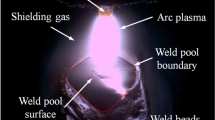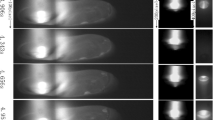Abstract
Even though arc welding is widely utilized to join metallic parts with high reliability, the prediction and control of welding quality is challenging owing to difficulties in the prediction of weld penetration depth and the backside bead. In this study, an effective method for predicting weld penetration based on deep learning was proposed to control the welding quality in-process. The topside weld pool image was closely related to the welding quality and penetration depth and was also an accurate indicator of the state of welding over time. A prediction model for penetration depth using a topside weld pool image was constructed. Semantic segmentation based on a residual neural network was then performed on the acquired weld pool image. Consequently, an accurate weld pool shape was extracted. In addition, a penetration regression model was constructed based on a back-propagation neural network. Finally, the penetration depth (corresponding to the weld pool shape) was extracted via segmentation. The segmentation and regression models were combined to create a penetration prediction model. Considering a gas tungsten arc welding (GTAW) process, the predictions obtained from the proposed method were evaluated experimentally. In the validation process, the developed model quantitatively predicted the penetration depth in tungsten gas arc welding. The mean absolute error was 0.0596 mm with an R2 value of 0.9974. The model developed in this study can be utilized to predict weld depth penetration and in-processing time using surface images of the weld pool.











Similar content being viewed by others
References
Kovacevic, R., Zhang, Y. M., & Li, L. (1996). Monitoring of weld joint penetration based on weld pool geometrical appearance. Welding Journal, 75(10), 317–329
Bae, K. Y., Lee, T. H., & Ahn, K. C. (2001). An optical sensing system for seam tracking and weld pool control in gas metal arc welding of steel pipe. Journal of Materials Processing Technology, 120, 458–465. https://doi.org/10.1016/S0924-0136(01)01216-X
Wang, Z., Zhang, C., Pan, Z., Wang, Z., Liu, L., Qi, X., Mao, S., & Pan, J. (2018). Image segmentation approaches for weld pool monitoring during robotic arc welding. Applied Sciences, 8(12), 2445. https://doi.org/10.3390/app8122445. MDPI AG
Chen, Z., Chen, J., & Feng, Z. (2019). Monitoring weld pool surface and penetration using reversed electrode images. Welding Journal, 96(10), 367–375. https://doi.org/10.3390/app8122445
Zhang, Y. M., Cao, Z. N., & Kovacevic, R. (1996). Numerical Analysis of Fully Penetrated Weld Pools in Gas Tungsten Arc Welding. Proceedings of the Institution of Mechanical Engineers, Part C: Journal of Mechanical Engineering Science, 210(2), 187–195. https://doi.org/10.1243/PIME_PROC_1996_210_185_02
Hong, Y., Chang, B., Peng, G., Yuan, Z., Hou, X., Xue, B., & Du, D. (2018). In-process monitoring of lack of fusion in ultra-thin sheets edge welding using machine vision. Sensors (Basel, Switzerland), 18(8), 2411. https://doi.org/10.3390/s18082411., MDPI AG
Fang, J., & Wang, K. (2019). Weld pool image segmentation of hump formation based on Fuzzy C-Means and Chan-Vese model. Journal of Materials Engineering and Performance, 28, 4467–4476. https://doi.org/10.1007/s11665-019-04168-y
Giridharan, P. K., & Murugan, N. (2009). Optimization of pulsed GTA welding process parameters for the welding of AISI 304L stainless steel sheets. International Journal of Advanced Manufacturing Technology, 40, 478–489. https://doi.org/10.1007/s00170-008-1373-0
Wang, X., & Li, R. (2014). Intelligent modelling of back-side weld bead geometry using weld pool surface characteristic parameters. Journal of Intelligent Manufacturing, 25, 1301–1313. https://doi.org/10.1007/s10845-013-0731-4
Mahadevan, R. R., Jagan, A., Pavithran, L., Shrivastava, A., & Selvaraj, S. K. (2021). Intelligent welding by using machine-learning techniques. Materials Today: Proceedings, 46(2), 7402–7410. https://doi.org/10.1016/j.matpr.2020.12.1149
El Ouafi, A., Bélanger, R., & Méthot, J. (2011). Artificial neural network-based resistance spot welding quality assessment system. Metallurgical Research & Technology, 108(6), 343–355. https://doi.org/10.1051/metal/2011066
Ismail, M. I., Okamoto, Y., & Okada, A. (2013). Neural network modeling for prediction of weld bead geometry in laser microwelding. Advances in Optical Technologies, 2013, 415837 (pp 1–7). https://doi.org/10.1155/2013/415837
Chokkalingham, S., Chandrasekhar, N., & Vasudevan, M. (2012). Predicting the depth of penetration and weld bead width from the infra red thermal image of the weld pool using artificial neural network modeling. Journal of Intelligent Manufacturing, 23, 1995–2001. https://doi.org/10.1007/s10845-011-0526-4
Kesse, M. A., Buah, E., Handroos, H., & Ayetor, G. K. (2020). Development of an artificial intelligence powered TIG welding algorithm for the prediction of bead geometry for TIG welding processes using hybrid deep learning. Metals, 10(4), 451. https://doi.org/10.3390/met10040451. MDPI AG
Yu, R., Han, J., Zhao, Z., & Bai, L. (2020). Real-time prediction of welding penetration mode and depth based on visual characteristics of weld pool in GMAW process. Ieee Access : Practical Innovations, Open Solutions, 8, 81564–81573. https://doi.org/10.1109/ACCESS.2020.2990902
Chen, Z., Chen, J., & Feng, Z. (2018). Welding penetration prediction with passive vision system. Journal of Manufacturing Processes, 36, 224–230. https://doi.org/10.1016/j.jmapro.2018.10.009
Cao, Y., Wang, X., Yan, X., Jia, C., & Gao, J. (2020). Prediction of fusion hole perforation based on arc characteristics of front image in backing welding. Materials (Basel Switzerland), 13(21), 4706. https://doi.org/10.3390/ma13214706
Keshmiri, S., Zheng, X., Chew, C. M., & Pang, C. (2015). Application of deep neural network in estimation of the weld bead parameters. In proceedings of 2015 IEEE/RSJ International Conference on Intelligent Robots and Systems (IROS), 3518–3523. https://doi.org/10.1109/IROS.2015.7353868
Li, Y., Hu, M., & Wang, T. (2019). Weld image recognition algorithm based on deep learning. International Journal of Pattern Recognition and Artificial Intelligence, 34(8), https://doi.org/10.1142/S0218001420520047
Cheng, Y., Chen, S., Xiao, J., & Zhang, Y. (2021). Dynamic estimation of joint penetration by deep learning from weld pool image. Science and Technology of Welding and Joining, 26(4), 279–285. https://doi.org/10.1080/13621718.2021.1896141
Jiao, W., Wang, Q., Cheng, Y., & Zhang, Y. (2021). End-to-end prediction of weld penetration: A deep learning and transfer learning based method. Journal of Manufacturing Processes, 63, 191–197. https://doi.org/10.1016/j.jmapro.2020.01.044
Jiao, W., Wang, Q., Cheng, Y., Yu, R., & Zhang, Y. (2020). Prediction of weld penetration using dynamic weld pool arc images. Welding Journal, 99, 295–302. https://doi.org/10.29391/2020.99.027
Li, C., Wang, Q., Jiao, W., Johnson, M. T., & Zhang, Y. (2020). Deep learning-based detection of penetration from weld pool reflection images. Welding Journal, 99, 239–245. https://doi.org/10.29391/2020.99.022
Shelhamer, E., Long, J., & Darrell, T. (2017). Fully convolutional networks for semantic segmentation. IEEE Transactions on Pattern Analysis and Machine Intelligence, 39, 640–651. https://doi.org/10.1109/TPAMI.2016.2572683
He, K., Zhang, X., Ren, S., & Sun, J. (2016). Deep Residual Learning for Image Recognition. In proceedings of 2016 IEEE Conference on Computer Vision and Pattern Recognition (CVPR), 770–778. https://doi.org/10.1109/cvpr.2016.90
Chollet, F. (2015). Keras. https://github.com/fchollet/keras
Deng, J., Dong, W., Socher, R., Li, L., Li, K., & Fei-Fei, L. (2009). ImageNet: A large-scale hierarchical image database. In proceedings of 2009 IEEE Conference on Computer Vision and Pattern Recognition, 248–255. https://doi.org/10.1109/cvprw.2009.5206848
Sheela, K. G., & Deepa, S. N. (2013). Review on Methods to Fix Number of Hidden Neurons in Neural Networks. Mathematical Problems in Engineering, 2013, 1–11. https://doi.org/10.1155/2013%2F425740
Yotov, K., Hadzhikolev, E., & Hadzhikoleva, S. (2020). Determining the number of neurons in artificial neural networks for approximation, trained with algorithms using the jacobi matrix. TEM Journal, 9(4), 1320–1329. https://doi.org/10.18421/tem94-02
Acknowledgements
This study has been conducted with support from the Korea Institute of Industrial Technology under “The dynamic parameter control based smart welding system module development for the complete joint penetration weld (KITECH EH-21-0003).”
Author information
Authors and Affiliations
Corresponding authors
Ethics declarations
Competing interests
The authors declare no competing interests.
Compliance with ethical standards
The authors comply with the Journal of Intelligent Manufacturing’s research ethical standards and declare no conflict of interests.
Additional information
Publisher’s Note
Springer Nature remains neutral with regard to jurisdictional claims in published maps and institutional affiliations.
Rights and permissions
Springer Nature or its licensor holds exclusive rights to this article under a publishing agreement with the author(s) or other rightsholder(s); author self-archiving of the accepted manuscript version of this article is solely governed by the terms of such publishing agreement and applicable law.
About this article
Cite this article
Baek, D., Moon, H.S. & Park, SH. In-process prediction of weld penetration depth using machine learning-based molten pool extraction technique in tungsten arc welding. J Intell Manuf 35, 129–145 (2024). https://doi.org/10.1007/s10845-022-02013-z
Received:
Accepted:
Published:
Issue Date:
DOI: https://doi.org/10.1007/s10845-022-02013-z




